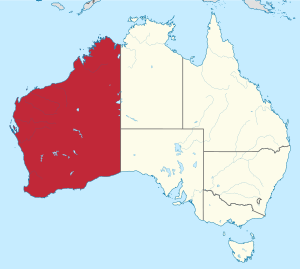
Back Wes-Australië Afrikaans Australia Occidental AN Westerne Australand ANG أستراليا الغربية Arabic ؤسطراليا دلغرب ARY ويسترن اوستراليا ARZ Australia Occidental AST Qərbi Avstraliya Azerbaijani غربی اوسترالیا AZB Ostrali Kawan BAN
Western Australia | |
|---|---|
Nickname(s):
| |
Location of Western Australia in Australia 26°S 121°E / 26°S 121°E | |
| Country | Australia |
| Before federation | Colony of Western Australia |
| Established as the Swan River Colony | 2 May 1829 |
| Responsible government | 21 October 1890 |
| Federation | 1 January 1901 |
| Capital and largest city | Perth |
| Administration | 139 local government areas |
| Demonym(s) |
|
| Government | |
• Monarch | Charles III |
• Governor | Chris Dawson |
• Premier | Roger Cook (Labor) |
| Legislature | Parliament of Western Australia |
| Legislative Council | |
| Legislative Assembly | |
| Judiciary | Supreme Court of Western Australia |
| Parliament of Australia | |
• Senate | 12 senators (of 76) |
| 15 seats (of 151) | |
| Area | |
• Total | 2,527,013[1] km2 (975,685 sq mi) (1st) |
| Highest elevation | 1,249 m (4,098 ft) |
| Population | |
• June 2023 estimate | 2,878,600[2] (4th) |
• Density | 1.11/km2 (2.9/sq mi) (7th) |
| GSP | 2022 estimate |
• Total | AU$377.257 billion[3] (4th) |
• Per capita | AU$135,320 (1st) |
| HDI (2021) | very high · 2nd |
| Time zone |
|
| Postal abbreviation | WA |
| ISO 3166 code | AU–WA |
| Symbols | |
| Bird | Black swan (Cygnus atratus) |
| Fish | Whale shark (Rhincodon typus) |
| Flower | Red and green kangaroo paw (Anigozanthos manglesii) |
| Mammal | Numbat (Myrmecobius fasciatus) |
| Colour(s) | Black and gold |
| Fossil | Gogo fish (Mcnamaraspis kaprios) |
| Website | wa |
Western Australia (commonly abbreviated as WA) is a state of Australia occupying the western third of the land area of Australia, excluding external territories.[5] It is bounded by the Indian Ocean to the north and west, the Southern Ocean to the south, the Northern Territory to the north-east, and South Australia to the south-east. With a total land area of 2,527,013 square kilometres (975,685 sq mi),[5] Western Australia is Australia's largest state as well as the second-largest subdivision of any country on Earth, surpassed only by the Sakha Republic in eastern Russia. As of 2021,[update] the state has 2.76 million inhabitants—11 percent of the national total.[6] The vast majority (92 percent) live in the south-west corner; 79 percent of the population lives in the Perth area,[7] leaving the remainder of the state sparsely populated.
The first Europeans to visit Western Australia belonged to the Dutch Dirk Hartog expedition, who visited the Western Australian coast in 1616. The first permanent European colony in what is today Western Australia occurred following the landing by Major Edmund Lockyer on 26 December 1826 of an expedition on behalf of the New South Wales colonial government.[8][text–source integrity?] Lockyer established a convict-supported military garrison at King George III Sound, at present-day Albany, and on 21 January 1827[8] he formally took possession for the British Crown of the western part of the continent that was not already claimed by the Crown.[9] This was followed by the establishment of the Swan River Colony in 1829, including the site of the present-day capital, Perth.
York was the first inland settlement in Western Australia. Situated 97 kilometres (60 miles) east of Perth, it was settled on 16 September 1831.[10] Western Australia achieved responsible government in 1890 and federated with the other British colonies in Australia in 1901.
Today, Western Australia's economy mainly relies on mining, oil and gas, services and construction. The state produces 46 percent of Australia's exports.[11] Western Australia is the largest iron ore producer in the world.[12] Its nickname is "The Wildflower State".[13]
- ^ "Area of Australia - States and Territories". 27 June 2014.
- ^ "National, state and territory population, June 2023 | Australian Bureau of Statistics".
- ^ "Western Australian Economic Notes – Gross State Product – 2021-22" (PDF). Archived from the original on 31 August 2021. Retrieved 16 September 2023.
- ^ "Sub-national HDI – Area Database – Global Data Lab". hdi.globaldatalab.org. Retrieved 18 February 2023.
- ^ a b Cite error: The named reference
ga20was invoked but never defined (see the help page). - ^ "National, state and territory population, March 2021 | Australian Bureau of Statistics". abs.gov.au. 16 September 2021. Retrieved 3 March 2022.
- ^ Cite error: The named reference
ABSCapitalPopwas invoked but never defined (see the help page). - ^ a b "King George's Sound Settlement". State Records Authority of New South Wales. Retrieved 30 August 2016.
- ^ Cite error: The named reference
rei08was invoked but never defined (see the help page). - ^ Knibbs, G.H. (1911). "The Creation of the Several Colonies". Official Year Book of the Commonwealth of Australia. Vol. 4. Melbourne: Commonwealth Bureau of Census and Statistics. p. 16.
- ^ Curran, Enda (21 February 2012). "Western Australia Plans Sovereign Wealth Fund". The Wall Street Journal. Retrieved 15 March 2012.
- ^ "US Geological Survey" (PDF). Minerals.usgs.gov. 2014. Retrieved 11 June 2016.
- ^ Thomas, Abbie (2 August 2002). "Western Australian wildflowers bloom". abc.net.au. Retrieved 3 November 2020.
© MMXXIII Rich X Search. We shall prevail. All rights reserved. Rich X Search


